An Express that has Earned World-wide Renown for Comfort Combined with Speed
FAMOUS TRAINS - 3
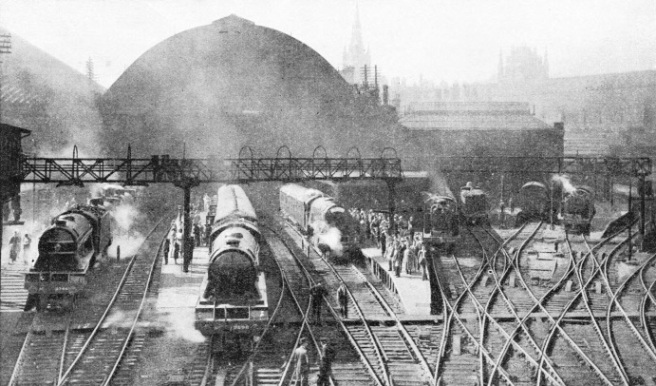
KING’S CROSS STATION, the London starting place of the north-bound “Flying Scotsman”.
FOR nearly three-quarters of a century the “Flying Scotsman” has left King’s Cross for Edinburgh. It is doubtful if this record can be challenged by any other train in the world. The details of the journey were disturbed only during the short period at the end of the War when, owing to the imperative need of reducing train services, the “Scotsman” was combined with a train to Leeds and Bradford, and the starting time was temporarily altered to 9.30 am.
Except for that break, this famous express has made its daily departure at 10 am since June, 1862, from No. 10 platform at King’s Cross, while the up “Scotsman”, inaugurated at the same date has, with the exception of a short period during its earlier history, started from the Waverley Station, Edinburgh, at the same hour for London.
Since then nearly 45,000 journeys have been made, and the “Flying Scotsman” has travelled for a total of eighteen million miles between London and Edinburgh alone, apart from the still longer journeys of the portions of the train which run through to Glasgow, Perth and Aberdeen.
Every year the mileage run by the “Flying Scotsman” between the English and Scottish capitals would be sufficient to take each of the two trains on the service roughly five times round the world.
During this long life tremendous changes have taken place. When the “Flying Scotsman” first ran, the coaches of which it was composed were six-wheelers; corridors had not been heard of and dining cars were unknown. Not until 1900 was a really up-to-date seven-coach train, made up entirely of twelve-wheeled cars carried on six-wheeled bogies, introduced to the service.
These fine vehicles were 64 ft 6 in long, of an American pattern, with bow-end and the American “buck-eye” type of steel-coupling, which has been standard ever since for main-line stock on the East Coast route, and is one of the secrets of the smooth travelling for which these East Coast trains have been famous.
Until 1900 the “Flying Scotsman” had always stopped for twenty minutes at York while its passengers ate a hasty lunch in the station dining-room; but dining cars were included with the new coaches and the stop at York was cut from twenty minutes to under ten minutes. The seven-coach train of 1900 weighed 265 tons, and added at least 30 per cent to the weight of the trains that had been in use up till then.
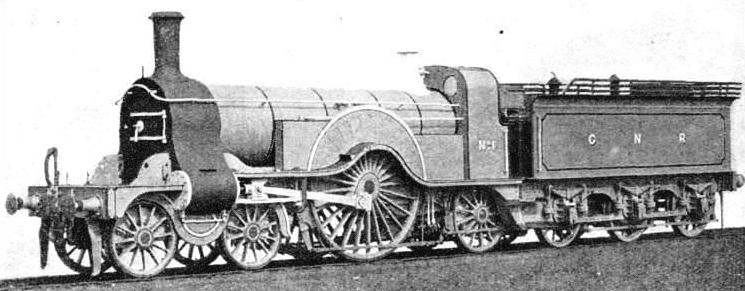
A FAMOUS FLYER of 1870. This famous locomotive, designed by Patrick Stirling of the old Great Northern Railway, was one of the fastest engines in Great Britain. The driving wheels were 8 ft 1 in diameter, and engines of this type hauled the “Flying Scotsman” all the year round between London and York.
From 1900 onwards the rolling-stock on the “Flying Scotsman” has grown more and more luxurious, while the train itself has become steadily longer and heavier, until the formation now generally in use is seldom fewer than fourteen coaches - twice the number as the train of 1900 - with a total weight of over 450 tons. At holiday times its weight frequently exceeds 500 tons, and has been known to rise to 600 tons, eighteen vehicles in all. During the summer months the “Scotsman” has to be run daily in two parts, the first of which cuts out all intermediate stops, making the non-stop run of 392.7 miles between King’s Cross and Edinburgh. We shall deal with this interesting point later in this chapter.
No less revolutionary has been the development of motive power. It was in the year 1870 that the first of the famous “8-footers”, which for many years were to work the “Flying Scotsman” between King’s Cross and York, was designed by Patrick Stirling, and built at Doncaster for the Great Northern Railway. These famous engines, among the most beautiful and graceful locomotive types that this country has ever seen, were distinguished mainly by their one big pair of single driving wheels, the diameter of which was 8 ft 1 in. Outside cylinders (18 in diameter by 28 in stroke) were provided; the total heating surface of the boiler was 1,165 sq ft; the working pressure 140 lb per sq in, and the weight of the engine, in running trim, 38½ tons.
The weight of later engines of this type was increased to 45 tons, and the working pressure to 160 lb. Among other distinctive external features of these engines was that the boiler carried no dome but, as was customary in all Stirling designs, was bare of mountings from the chimney right back to the safety-valves. No. 1, the first of the Stirling “8-footers”, can be seen in the Railway Museum at York.
Revolutionary Changes
But the introduction of the new and heavier coaches in 1900 began to tax the single-drivers beyond their powers. In 1895 Stirling died, and his place had been taken at Doncaster by H. A. Ivatt, who in 1898 produced his first “Atlantic” or 4-4-2 locomotive, with four-coupled in place of single driving-wheels, and a considerably larger boiler.
But it was in 1902 that an even more revolutionary change came about by providing one of these engines - No. 251 - with a much larger boiler. In fact, the 5 ft 6 in diameter of this latter boiler was one of the biggest that had been seen in Great Britain up to that time. The efficiency and reliability of a locomotive, Ivatt said, was measured by its “capacity to boil water”, and though for the size of these engines the cylinders, 18¾ in diameter by 24 in stroke, were small, the boilers, with their characteristic wide fireboxes, spread right across the frames, could supply unlimited quantities of steam.
These large-boilered Ivatt “Atlantics”, of which nearly one hundred were built, marked a turning-point in British locomotive design generally. Much important work over the southern area of the London & North Eastern Railway, south of York, is still entrusted to them, such as the working of the fast Pullman trains between King's Cross and Leeds. Only recently an engine of this type - a “veteran” 27 years old - worked the “Queen of Scots” Pullman express from London to Leeds, 185.8 miles, in just over three hours, and when due allowance was made for signal and permanent way delays, the net time worked out at no more than 175 minutes. For 136¼ miles, from Hatfield to mile-post 154, with this 290-ton train, No. 4433 maintained an average speed of 70.2 miles an hour.
The boilers of these engines have a heating surface of 2,500 sq ft, and the area of the fire-grate is 31 sq ft; only in the cylinders has any change been made in the original design, for since the introduction of super-heating they have been enlarged to 20 in diameter by 26 in stroke; the driving wheels are 6 ft 8 in diameter; and the weight of the engine in working order, without tender, is 68½ tons. The working pressure is fixed at 175 lb per sq in.


AN ARTICULATED RESTAURANT CAR forming part of the “Flying Scotsman” express. The illustration clearly shows the method of carrying two coach-ends on one bogie. A dining-car is placed at either end of the central kitchen car, which is fitted with the latest electric cooking appliances. The total length of the triple coach is 151 ft and it weighs, complete with its equipment, 83 tons.
These famous “Atlantics” reigned supreme for twenty years on the Great Northern Railway. In the same period various
4-4-0 types of locomotive which had been used by the North Eastern Railway to work the “Flying Scotsman” forward from York to Newcastle and Edinburgh had also given place to “Atlantics”, and similarly over the North British route from Edinburgh to Dundee and Aberdeen; throughout the whole of this distance 4-4-2 locomotives, of which scarcely any were used on other British railways, worked all the fast and heavy expresses.
But still the demand was insistent for heavier trains and more powerful locomotives. In 1911 Mr. H. N. Gresley had succeeded Ivatt at Doncaster, and in 1922 - exactly twenty years after the appearance of the first large-boilered “Atlantic” - there emerged from Doncaster Works the pioneer engines of the class which were destined, more than any other, to make Mr. Gresley’s name famous as a locomotive engineer. It was the first Gresley “Pacific”, then numbered 1470, and named “Great Northern”.
Four-coupled driving wheels were forsaken for six-coupled wheels, to give greater adhesion. A boiler of enormous dimensions, tapering out towards the firebox, was fitted; it gave no less than 3,455 sq ft of heating surface, and the area of the fire-grate was increased to 42 sq ft. A diameter of 6 ft 8 in was retained for the driving wheels, but the cylinders were increased both in size and number, three being now provided, of 20 in diameter and 26 in stroke. The working pressure was fixed at 180 lb per sq in, though a number of the later “Pacifies” have had their pressure increased to 220 lb.
With the increase in size and power, of course, came a great increase in weight; As compared with the 38½ tons of the first Stirling “8-footer”, No. 4470 weighed 92½ tons; with a large tender, carried on light wheels and accommodating 5,000 gallons of water and 8 tons of coal, the total weight rose to 146 tons.
The “Super-Pacifics”
The latest “Super-Pacifics”, with corridor tenders of even greater capacity, weigh 158¾ tons in running trim. Throughout its present-day journey from London to Edinburgh the “Flying Scotsman” is always “Pacific” hauled, and so vast an increase in tractive power is necessary, because, as previously mentioned, the weight of the train is seldom now less than 450 tons, which means 475 tons and more with passengers and luggage, and at busy times may rise to 550 or even 600 tons. Since the formation of the London & North Eastern Railway in 1923, these big “Pacifics” have become the standard type for heavy express passenger work in the LNER; eighty of them have been built, and they work over every section of the main line from London to Aberdeen.
Most of the “Pacifics” are named, appropriately, after famous racehorses. The best-known is probably the third engine of the type which was built, then No. 1472 and now 4472, named “Flying Scotsman”. On November 30, 1934, this locomotive made not only the fastest long-distance run that has ever been performed on the metals of any British railway, but it made also what was probably the fastest journey of its length ever made by steam.

THE “FLYING SCOTSMAN” Pacific-type locomotive shares the name of the express train which it hauls on its journeys between London and the North. The driving wheels of this engine are 6 ft 8 in diameter, and the three cylinders are 20 in diameter by 26 in stroke. The weight of the locomotive, complete with tender, is 155 tons. A corridor is provided inside the tender in order to enable one engine crew to be relieved by another on a non-stop journey, without slowing the train. The cost of this type of engine is £7,500.
A four-coach train was worked over the 185.8 miles from King’s Cross to Leeds in 152 minutes, and six coaches were worked back in 157 minutes on the same day, inclusive of severe slowings over various junctions. Of the one round trip 250 miles were covered by this eleven-year-old locomotive at the astonishing average of 80 miles an hour, 40 miles at an average of 90, and for a distance of 600 yards, on the up journey, speed rose to 100 miles an hour.
An even more notable locomotive was produced by Mr. Gresley at Doncaster in 1934 - the first of a type destined to take over the working of the “Flying Scotsman” north of Edinburgh. The gradients from here up the East Coast to Dundee and Aberdeen are very severe, and there are many points at which sharp curves require severe reductions of speed, after which, and in starting from the principal stations, the engines have to recover their speed up these steep hills. This calls not so much for high speed capacity as for great tractive power, to make rapid acceleration possible.
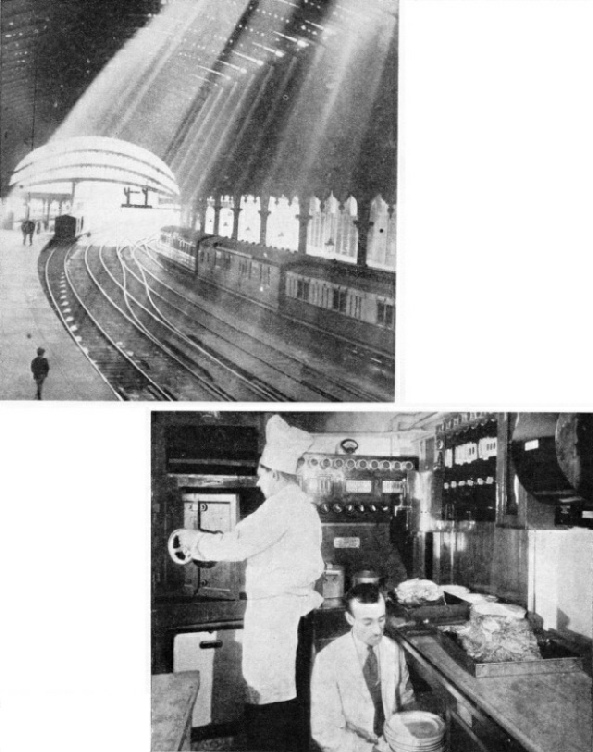
YORK, one of the principal stations on the route of the “Flying Scotsman”. York is 188 miles from the London terminus at King’s Cross.
COOKING BY ELECTRICITY. The chef and his assistant in the wonderful all-electric kitchen from which meals are served to travellers on the “Flying Scotsman”.
Thus “Cock o’ the North”, as the No. 2001 is called, has four pairs of driving-wheels coupled, instead of three, and is of the 2-8-2 type. By the use of streamlining this ultra-modern locomotive has been given an appearance quite different from the locomotive lines to which we are accustomed; and the streamlining conceals various other novel features (such as a double chimney) which have been adopted, with many other changes designed to give the steam as free a passage as possible from the boiler to the exhaust, as in present-day French practice. In every way “Cock o’ the North” is a revolutionary design.
When it first began to run, in June 1862, the “Flying Scotsman” carried first- and second-class passengers only, and 10½ hours were spent on the journey. Ten years later the time had been reduced to 9 hours 20 minutes, but still the third-class passenger was excluded. Not until November, 1887, after twenty-five years of running, was the decision at last reached that third-class passengers should be admitted to this celebrated train.
The announcement of an acceleration of the service in July, 1888, to a time of 8½ hours had a startling sequel. It was nothing less than a “race” between the companies forming respectively the East Coast and West Coast routes to Scotland, to show which could reach Edinburgh in the quicker time from London.
The fastest time made was 7 hours 26¾ minutes, and for a short while afterwards 7¾ hours appeared in the time-tables - a running record that was not to be repeated with the “Flying Scotsman” until forty-four years had passed.
But as a regular proposition it was rather in advance of the powers of the engines of the period, and so relapsed again to the 8½ hours originally proposed. At between 8½ and, latterly, 8¼ hours the time remained, except for slowing down during the War, until the end of 1932.
Meanwhile, there had been at least one remarkable development in the summer working of the “Flying Scotsman”. In 1927, the first of the two portions invariably run during the height of the season was booked without a stop from King’s Cross to Newcastle, a distance of 268.3 miles. But this was completely overshadowed in the following year, when, from May onwards, the “Flying Scotsman” was, for the first time, scheduled to make a non-stop run over the 392.7 miles between King’s Cross and Edinburgh. This run, by a wide margin the longest non-stop railway journey in the world, has continued in operation every subsequent year, for eight to ten weeks at the height of the season, and with extraordinary regularity. There have been summers during which the non-stop running has been carried through without a single mechanical failure on the locomotives or a single instance of late arrival.
The 8¼ hour schedule was still continued - by virtue of an agreement between the LNER and the LMS not to cut the times of the day trains below this figure - from 1928 to 1931 inclusive, so that performance, apart from being in a measure a test of endurance, was a comparatively easy one for the locomotives.
Unique Non-Stop Design
This performance, however, called for one special detail of equipment, which is found on no railway in the world other than the LNER. This is the corridor type of tender used on these runs. It was not regarded as advisable that one driver and fireman should man the engine for so long a period as 8¼ hours continuously; the strain on the driver of observing the signals controlled by something like 200 signal-boxes passed on the route, and on the fireman of shifting from 6 to 8 tons of coal on one continuous spell of duty, was rightly regarded as excessive. Arrangements had to be devised whereby the crew could be changed at the midway point on the run.
A new type of tender was therefore constructed, with a corridor passage down the side. The back of the tender has a vestibule connexion like that of a coach, which is connected up to the front coach on the train; from this a narrow passage, 18 in wide and 5 ft high, is conducted along the side of the tender to a door opening on to the footplate; the passage is lighted by a circular window in the end of the tender. At the midway point of the journey, when passing Alne, 11¼ miles north of York, the second crew, who up till then have been resting in a reserved compartment in the coach immediately behind the tender, pass through the front guard's brake and the tender corridor on to the footplate, where they exchange places with the crew which have worked the engine to this point.
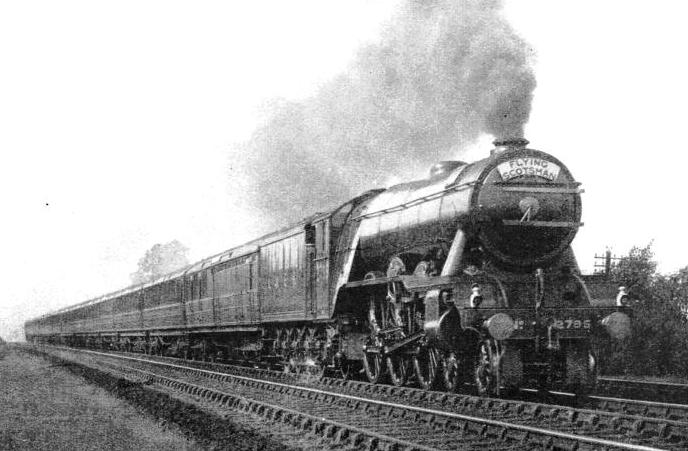
THE “FLYING SCOTSMAN” EXPRESS weighing over 400 tons, covers the 392¾ miles from London to Edinburgh at over 50 miles an hour. This picture gives a vivid impression of the famous train at high speed.
This arrangement is in force only during the period of non-stop running; for the rest of the year the locomotive used from London works through with its crew over the 268.3 miles to Newcastle, where engines are changed, and another “Pacific” is attached for the remaining 124.4 miles run to Edinburgh.
With their capacity for 5,000 gallons of water and 9 tons of coal, these huge corridor tenders weigh, when full, 56 tons apiece, or all but half as much again as the Stirling “8-footer” locomotives used in early “Flying Scotsman” days.
In May, 1932, a great acceleration of all the Anglo-Scottish services took place. The time of the “Flying Scotsman” from King’s Cross to Edinburgh, and in the reverse direction, was reduced to 7¾ hours, and the time on the up journey has since become 7 hours 40 minutes, which involves an average speed of 51.2 miles an hour throughout, including stops. The allowance for the non-stop summer journey was at the same time reduced to 7½ - 52.4 miles per hour - but the harder work is required on the winter run. For the up “Flying Scotsman” stops at Berwick, Newcastle, Darlington, York and Grantham; and when the duration of these stops is deducted, the time left is only 7 hours 25 minutes; moreover, the train is considerably heavier when the winter working is in force, because its two summer portions are then merged into one.
Let us look now at the “Flying Scotsman” as it stands at No. 10 platform at King’s Cross. Next to the engine comes a through composite coach - first and third class with a small luggage compartment - for Perth. After that there is the Glasgow portion - a brake third with a large luggage compartment and four third-class compartments, and a first- and third-class composite. Beyond this come a varying number of third-class compartment coaches, from two or four, according to traffic demands, all of the latest and most comfortable type, with arm-rests dividing up the seats into three places on each side.
Large toilet compartments are placed on these cars, and a supply of hot water can be obtained both winter and summer, for the heating is by electricity, and so is not dependent on the winter supply of steam-heat.
Down the side of the corridor of the next coach there are illuminated projecting signs, similar to those in the corridor of an hotel. The first door on the left is labelled “Hairdressing Saloon”, which caters for both men and women. Next to this is a “Ladies’ Retiring Room”, and then, after two or three third-class compartments, the “Cocktail Bar”. This is a delightfully-furnished room, with ultra-modern decorations in green and silver, and the pleasantest of haunts in which to pass half an hour on the journey.
Beyond the bar are the restaurant cars. The restaurant car unit is “articulated” in the well-known London and North-Eastern style.
In the kitchen all the cookery is carried out electrically. Large accumulators are charged before the run begins, and more electricity is made during the journey.
The first-class restaurant car on the “Flying Scotsman” is a luxurious conveyance, furnished and decorated throughout in the Louis XVI period style, with concealed lighting. So is the first-class compartment coach immediately following it, which incorporates some of the most modern ideas.
To enable everyone to identify this famous train, the name “The Flying Scotsman” is carried on the roof of each coach, on both sides; on a white name-board with black lettering on the front of the engine smoke-box; and in large white letters on the rear end of the last coach.
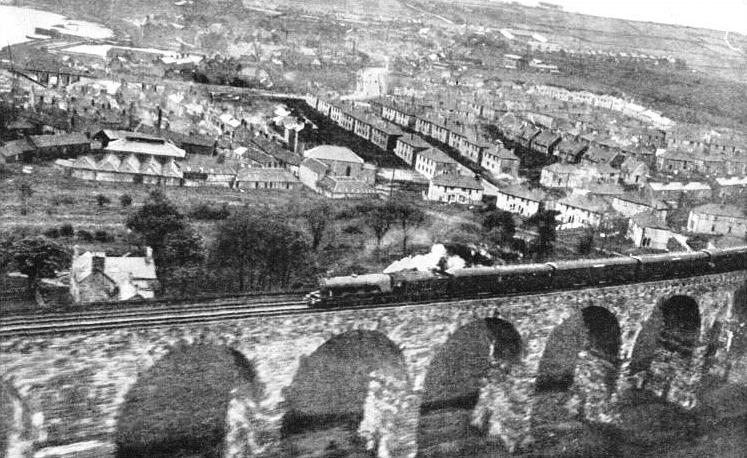
BERWICK BORDER BRIDGE spans the Tweed and links England with Scotland. A Scottish express is shown crossing the arches of this great viaduct.
You can read more on “The Aberdonian”, “The Great North Road of Steel” and “The Silver Jubilee” on this website.










